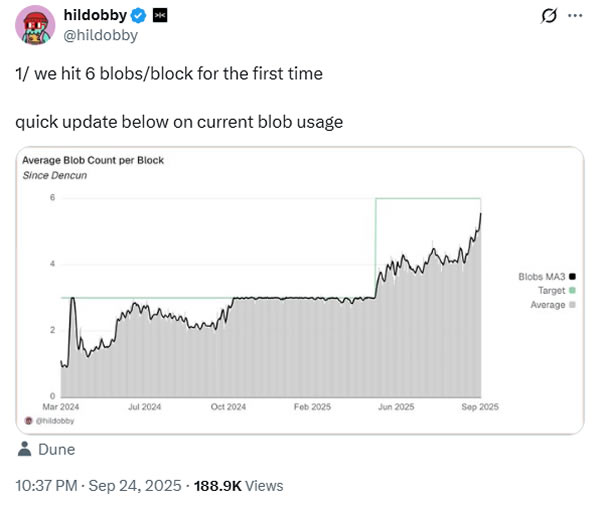Fusaka upgrade introduces PeerDAS, enabling Ethereum nodes to verify data availability by sampling small data chunks rather than downloading full blocks. This reduces Layer‑2 rollup costs and allows progressive increases in blob capacity, improving throughput and scalability for Ethereum users and L2 systems.
-
Fusaka adds PeerDAS to verify data availability via statistical sampling, cutting node bandwidth needs.
-
Blob capacity will increase in stages: an initial doubling and subsequent Blob Parameter Only forks raising max blob counts.
-
Blob usage spike driven by Base and Worldcoin; network reached six blobs per block target recently (Dune Analytics).
Fusaka upgrade: PeerDAS lets Ethereum nodes sample data to verify availability without full downloads—read the timeline, blob target changes, and expected L2 scaling impact now.
Ethereum co-founder Vitalik Buterin explained how Fusaka’s PeerDAS feature will address Ethereum layer 2 scaling bottlenecks.
What is the Fusaka upgrade?
Fusaka upgrade is a protocol update scheduled for Dec. 3 that introduces EIP‑7594 and PeerDAS, a data‑availability sampling system. It aims to let nodes verify availability by downloading small data chunks, lowering the Layer‑1 bottleneck for rollups and enabling higher Layer‑2 throughput.
How does PeerDAS verify data availability?
PeerDAS uses statistical sampling: nodes request and validate small random blob chunks instead of the full blob set. If sampled chunks are present across peers with expected frequency, nodes infer full data availability with high probability. EIP‑7594 formalizes the sampling rules introduced in January 2024.
Vitalik Buterin described PeerDAS as “the key to L2 scaling, and eventually L1 scaling.” The approach shifts trust from single full‑data downloads to distributed sampling, reducing per‑node storage and bandwidth needs.
Blob count hits new peak
Network blob usage has spiked recently. Hildebert Moulié (head of data at Dragonfly) noted the network reached the six blobs‑per‑block target for the first time this week. On‑chain activity driving the rise includes Coinbase’s Base and Worldcoin.
Blobs (Binary Large Objects) were introduced in the Dencun upgrade via EIP‑4844 (proto‑danksharding) to reduce rollup transaction costs by storing rollup data off‑chain in cheaper blob storage.

Blob count spiked this week. Source: Dune Analytics
Fusaka update: what changes to blob targets and capacity?
The Fusaka upgrade will introduce EIP‑7594 and an initial increase in blob target capacity. Developers plan staged capacity increases to protect network stability and allow cautious testing. Subsequent Blob Parameter Only (BPO) forks will further raise maximum blob counts.
| Stage | Target blobs per block | Planned maximum blobs per block |
|---|---|---|
| Current | 6 | 9 |
| Fusaka (Dec. 3) | 12 (initial doubling of target) | Planned increases via BPO forks |
| BPO fork 1 (post‑Fusaka) | 12 | 15 (planned) |
| BPO fork 2 (planned January) | 12 | 21 (planned) |
Ethereum researcher Christine Kim reported a plan to run two BPO forks after Fusaka to raise maximum blob counts in stages. Developers emphasize conservative rollout and extensive testing before aggressive capacity increases.
Why does PeerDAS matter for Layer‑2 rollups?
PeerDAS reduces the Layer‑1 data‑availability bottleneck that constrains rollup throughput and increases costs. By ensuring blob data exists across peers without full downloads, rollups can post and prove batches more cheaply and at higher rates.
That reduces per‑transaction fees for end users and enables rollups to scale more efficiently while keeping Ethereum security assumptions intact.
Frequently Asked Questions
How will Fusaka improve transaction costs for rollups?
By increasing blob capacity and enabling PeerDAS sampling, Fusaka reduces the per‑rollup cost of posting data to Layer‑1. Lower data bottlenecks allow rollups to batch more transactions, decreasing average fees for end users.
Does PeerDAS require changes to node software?
Yes. PeerDAS requires node implementations to support data sampling protocols defined in EIP‑7594 and related client updates. Core developers recommend cautious testing and staged deployments to ensure reliability.
Key Takeaways
- PeerDAS enables sampling: Nodes can verify data availability without full downloads, easing bandwidth and storage demands.
- Staged capacity increases: Fusaka initially raises blob targets; BPO forks will progressively raise maximum blob counts to support higher throughput.
- Real‑world drivers: Activity from Base and Worldcoin contributed to the recent blob spike, highlighting demand for larger blob capacity.
Conclusion
The Fusaka upgrade and PeerDAS together represent a practical path to easing Ethereum’s Layer‑1 data availability limits and unlocking greater Layer‑2 scalability. With careful testing and staged blob parameter changes, developers aim to boost rollup throughput while maintaining network stability. Watch for the Dec. 3 deployment and subsequent BPO forks for phased capacity increases.
